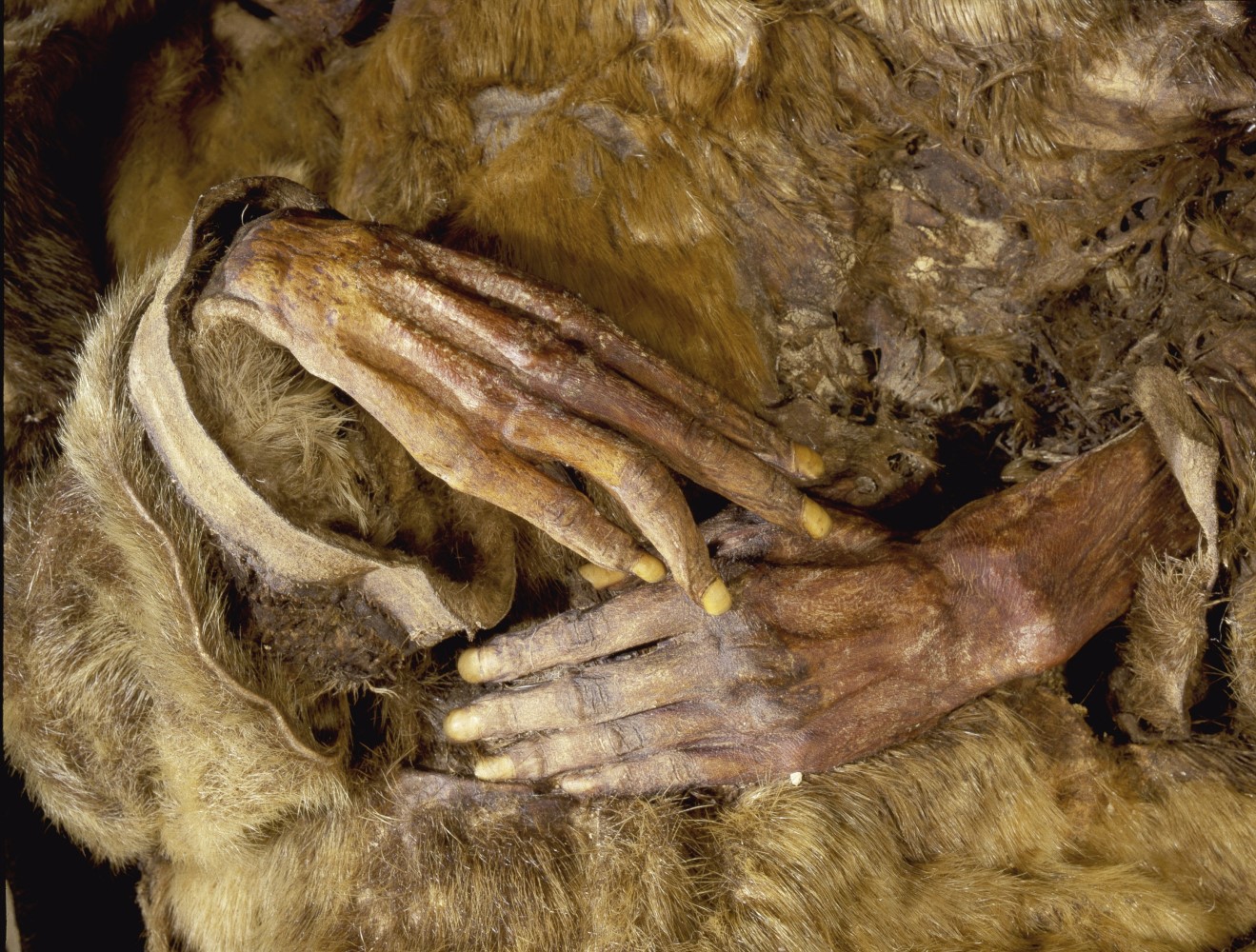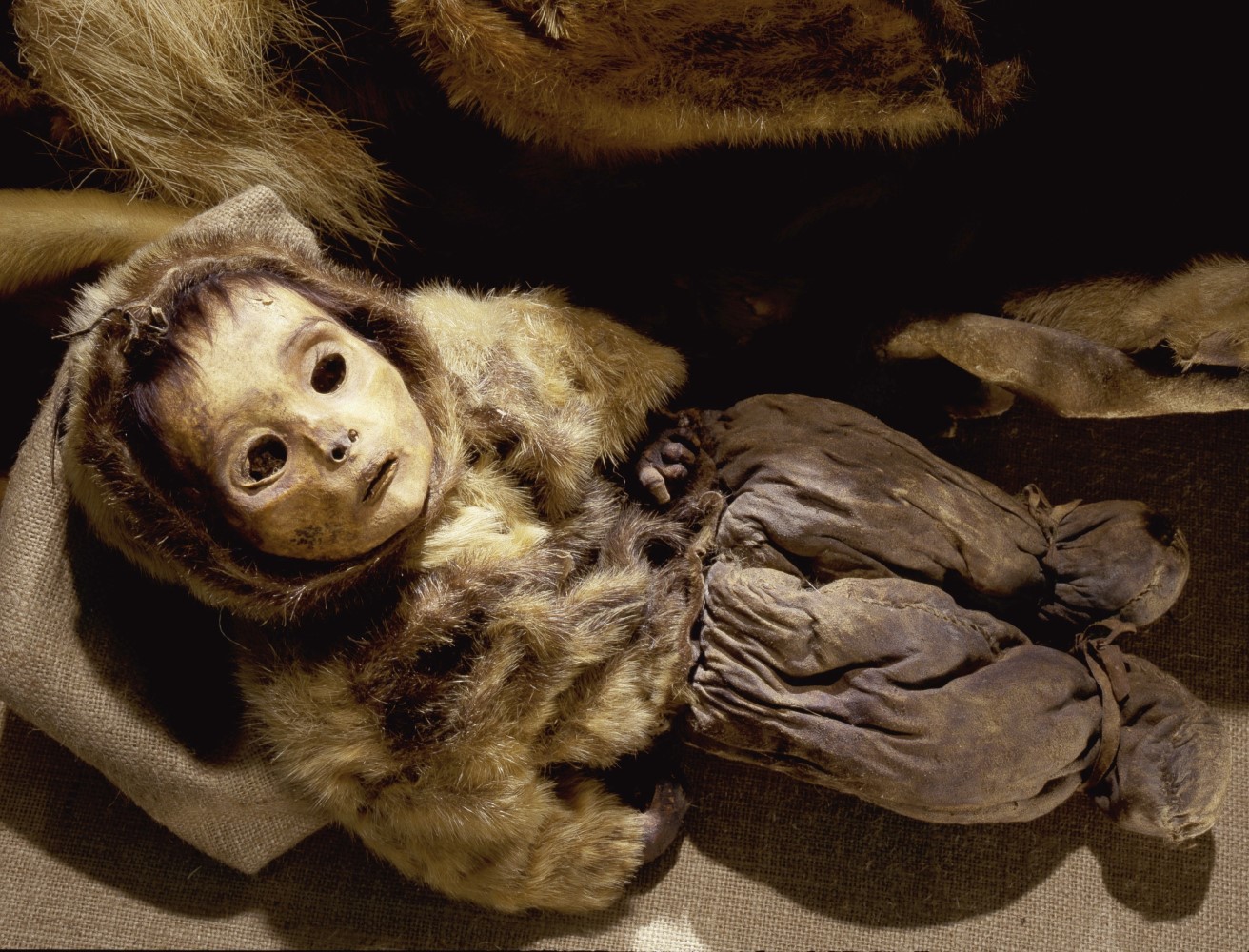Three mummy finds in Qilakitsoq, Pisissarfik and Uunartoq offer unique insight into the early skin products of the Inuit. The making and patterns of the well-preserved garments tell both about regional affiliations and the gender of the wearer, and in some cases, amulets hidden in the garments give insight into the Inuit worldview.
The mummies, consisting mainly of women and children, were buried close to where they lived. The mummification happened because of the low humidity and cold of the Greenlandic climate.
The Qilakitsoq mummies

WERNER FORMAN ARCHIVE/SHUTTERSTOCK/RITZAU SCANPIX, 1970
The Qilakitsoq mummies from the Uummannaq area in Northwest Greenland have been dated to 1475. Two stone-covered graves with mummified bodies were found by hunters in 1972, and in 1978 the Greenland National Museum excavated eight buried people – six women and two children aged around six months and four years. The mummified women and children were all buried with extra clothes, extra skins and grave goods. In total, there are 78 pieces of clothing, and the find gives a rare insight into what life was like in that place and at the time they lived.
Typical clothing consisted of an inner anorak of bird skin where the feathers were turned towards the body and the edges were sewn with caribou skin. The outer anorak could be made of either sealskin or caribou skin, in which case the fur would face outwards. Both the inner and outer anorak had hoods. The trousers were either thigh-length or went down to the knee and were made of sealskin or caribou skin.
The kamiks were made of hairless sealskin, and under these they wore stockings made of sealskin or caribou skin. The lower part of the kamik was lined with grass for comfort and warmth.
The garment was aesthetic with symmetrical patterns created using dark and light leather.
Children’s garment

WERNER FORMAN ARCHIVE/SHUTTERSTOCK/RITZAU SCANPIX, 1970
The four mummies found at Pisissarfik in Nuuk Fjord are estimated to have been buried in the 17th century. Among these four were two infants. The Uunartoq mummies from South Greenland have been dated to the 16th century. Among an unknown number of mummies there were three infants. Together with the two children from Qilakitsoq, they provide a rare insight into the children’s world, which can be difficult to interpret archaeologically.
The infant from Qilakitsoq was dressed in a sealskin anorak with a close-fitting hood and trousers with integrated feet. The four-year-old boy was dressed in an inner and outer anorak, trousers, socks and kamiks – all made of sealskin. The trousers were sewn with large stitches and many knots, and the kamiks, although well made, had many patches under the soles and scratches on the legs. The wear marks testify to a lively childhood, the high quality of the stockings and the ornamentation on the outer anorak are testament to a mother’s love.
The total of six mummified infants, separated in time and space along the west coast of Greenland, tell us about both the high infant mortality rate and the care and attention the infants received during their short lives. Their garments show that the differences in men’s and women’s garments only become significant later in life.
Although the women were seasoned seamstresses, the work of sewing sinew through hides has been hard, and especially in winter the poor light from a blubber lamp has required concentration and precision. The ornamentation on the clothes is therefore attributed a greater function than pure aesthetics – it probably had a symbolic meaning.
Women’s face tattoos
The five oldest women from the grave at Qilakitsoq had almost identical line tattoos on their foreheads, and it is not yet known whether the women from Pisissarfik and Uunartoq are tattooed since the mummies have not yet been examined for tattoos. However, it is very likely that these women also had facial tattoos, since historical sources tell of the tradition from the beginning of the 17th century until colonisation in 1721 on the west coast and until 1895 on the east coast.
The tattoos, together with the patterns on the garments, can be interpreted as a visual language with a protective function. Many of the same patterns recur on hunting tools and the hunting scene engraved on the walrus tooth from Nuulliit.
Further reading
- Four tales illustrated by Aron of Kangeq
- Inuit way of life
- Museums of cultural history and heritage
- Paleo-Inuit
- The Inuit culture, precolonial period
- Traditions and tales
Read more about History in Greenland
